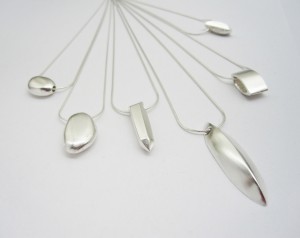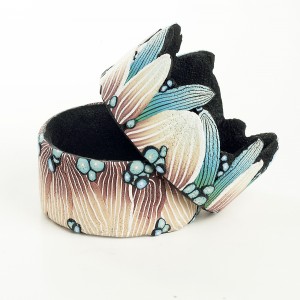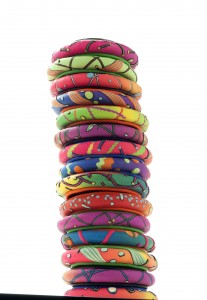I probably should have put a warning notice upfront before I began this series of posts on the elements and principles of design. Although I’m going to discuss each of these separately, it’s really impossible to separate them. While I danced around this in my posts on shape, I can’t tap dance fast enough to get around it here, when we begin to look at form. Because this is where the language gets muddy. Stick with me and see. Continue reading
Pricing Your Production Line
You have a jewelry line you enjoy making. Your friends like it. Your family likes it. Your co-workers and neighbors like it. They—and you—are all sure you can make a living selling it.
Can you?
It depends on the price. Continue reading
Quote for Monday, September 21, 2015
Aside
“Genius is talent set on fire by courage.”
Henry van Dyke
Quote for Monday, September 28, 2015
Aside
“Plato maintained that all art is a gift from the gods, channeled through artists who are ‘out of their mind’–quite literally, in Plato’s view—when making art.”
Art & Fear by David Bayles and Ted Orland
Is Wholesaling Right for You?
When you wholesale, you sell you work to an outlet of some kind that resells your work—for a profit—to the person who will actually wear it. Production jewelry lines are made for wholesaling. The pieces are usually less expensive and easier to produce than one-of-a-kind work. Your distributors can sell them at a reasonable price point, which makes them great impulse items. Customers can easily make the decision to buy a production piece without meeting you, the artist, or even without a lot of input from a sales associate at a gallery or department store.
Wholesaling allows you to have your work in a retail venue—all the time—without the expense of a storefront, or the time and bother of creating and maintaining a website. You can present your work in many venues at one time–across the country or on the other side of the world–without having to travel to those venues yourself. Best of all, it means you can stay in the studio doing what you do best and may enjoy most: making jewelry.
Wholesaling may also be a good fit if you work another job. You may not be able to go to retail art and craft shows, and maintaining an Internet presence may take away from what little time you have at the bench.
However, wholesaling does separate you from the consumer. You may not get the kind of feedback from gallery or boutique sales staff that you would from the people who will be wearing your work. If the gallery is not local, you may not know how your jewelry is displayed, how often gallery staff actually show pieces to a customer, or what they’re saying about it. Some venues, too, may be less careful handling your work than you are and damage can happen.
Probably the biggest drawback to wholesaling is that most galleries—which are probably the primary wholesale venues for jewelry makers starting their career–work on consignment. This means that, although the gallery provides a permanent retail space where your work can be seen, you bear all the costs of production and are only paid when—and if—the work is sold.
If you decide that wholesaling might be your best approach to selling your production jewelry line, there are several ways to find outlets for your work.
Gemstones for Men

Bracelets, including gem-set and gemstone beads, are growing in popularity as fast or faster than rings. Photo courtesy Eli Halili Jewelry.
For the last five to seven years, trade press and jewelry bloggers have commented on the growing demand for men’s jewelry. While a good part of this growth has been due to an increasing number of men’s wedding ring purchases, men’s fashion rings have also seen a bounce. Bracelets, too, are in great demand. “If men are not buying a wedding ring,” says Israeli-born New York designer Eli Halili, “they’re buying a bracelet.” Bracelets are also prevalent in the offerings of designers such as William Henry, and the world-renowned David Yurman. Continue reading
Quote for Monday, September 14, 2015
Aside
“In alchemy, the Latin word labor is used to describe the procedures, methods and techniques—the daily struggle with materials. Also in Latin, ora means prayer, and the alchemists never tired of point out that labor and ora spell laboratory. As in the artist’s studio, so in the alchemist’s laboratory: both of them mingle labor and ora.”
James Elkins, What Painting Is
Retailing Your Jewelry: Sell It Online
Selling your production jewelry line at retail art and craft shows is a great way to meet your customers, get valuable feedback on your designs, and get a shot of energy from the people who love your pieces. But if the thought of selling face-to-face freezes your blood, and you still aren’t ready to produce the volume you might need to wholesale your line, you’re in luck. You can sell your work through your own website or through an online marketplace—or both.
Your website is like having your own retail shop, only it’s open 24/7. It’s all about you and your story. It’s where you can focus and individualize your brand through the use of layout, colors, fonts, and the information you provide. You can express your personality through the voice you use when writing your bio and your artist statement. (Yes, you’ll have to have them both. You can write your own, or work with a professional to create them.) You can blog, have a newsletter to stay in contact with customers, and link to other artists. Your website is your world.
And because it is your world, you have to be conscious of how you present yourself—and your work. The site should be professional looking. All the links should work correctly, and allow your visitors to navigate your site easily from one piece to another. People should be able to buy and pay for your work quickly. A contact form gives them the opportunity to ask questions. (Always respond promptly, of course.)
Professional-level photos are non-negotiable. Your buyers can’t actually hold your jewelry, so your photos must give them the best experience possible. Learn how to take high-quality photos or hire someone who can do it right. Include multiple views. And always include a description that includes any or all of the following information: metal and stone types, sizes, weights, manufacturing techniques, and story. (If you’re a whiz at CAD, and are selling from a virtual store, you won’t, of course, need photos. But the quality will still have to be high, and it will help if customers can rotate the image to see it from various directions.)
You can set up your own up website using online website builders such as Squarespace or WordPress, or you can hire a professional website designer. Either way, be sure all elements of your website are consistent in presenting your brand.
You can avoid the development of your own website by selling through an online marketplace, such as Etsy or Artfire. These are more like selling in a mall. Your work is presented with others at random. Buyers can skim through images quickly and comparison shop for design and price. “Shops” are much less individual and there is less opportunity to impress your brand on them. But they’re usually pretty easy to set up and maintain. You’ll save the costs and time associated with creating your own website, but marketplaces usually charge commissions or membership fees for your shop.
Marketplaces usually provide a way for potential buyers to contact you directly or to jump to your website. They can be a good place to reach a broad audience, especially when you’re just starting out. You can discover if your work is selling, how it compares to other, similar work, and who’s buying.
And you won’t have to talk to people directly.
Are Retail Shows Right for You?
Selling your production jewelry at a retail show seems to be a “no-brainer”—you have work you want to sell and that’s where there are a lot of customers. But not everyone is cut out for retailing and not every show is “your” show. There are some things you should consider.
First, do you enjoy talking to people about your work? Are you energized by selling directly to a wearer? If you’re terminally shy, selling to the public might not be for you. (Though if you just hate “selling” you can look at last week’s post on some tips to make it less painful.) If you really can’t bear to talk to people, but retail sales seem like the best outlet, consider online sales. (You will still have to communicate with people—and this time via writing, which is even worse for some people than talking.) There’s always the option of hiring friend—or trading for jewelry—to work the show for you. However, most buyers at an art show want to talk to the maker. Otherwise, they can go to a gallery.
Second, is this your show? Always visit the show you want to enter before you lay down your entry fee. Look around. Who are the attendees? What’s their demographic as far as age, lifestyle, earning potential goes? Does your work fit with the products being sold in terms of price, style, materials? What is the environment like in terms of lighting, space, parking, security? Do sales appear to be good or are there more lookers than buyers? Can you determine why?
Third, how far away is the show and how will you get yourself, your booth, and your work there? Airfare, shipping, hotels can quickly add to the cost of a show. John and Corliss Rose, of Two Roses in Anaheim, California, only attend local shows in order to keep costs down. If you must attend distant shows, for whatever reason, you may want to limit the number of such shows you do a year. Or, if you like the gypsy life, outfit an RV with a shop so you can travel and work on the road.
Fourth, what are the costs? What is the potential return in sales or in marketing information? Do these outweigh the financial costs as well as the time lost in the studio?
Fifth, do you need the feedback you can only get from real customers? Are you introducing a new line or design? Are you trying to break into a new market or a new demographic, are you using a new material? Going into a retail show and meeting customer face to face is often the only way you can find out if you’re on the right track. The Roses, who sell primarily wholesale, always participate in a few retails shows a year, just so they can get exactly this kind of invaluable information.
You may have to experiment a bit at the beginning—or any time you make a change in your product—in order to find out whether or not the “show fits.”
Quote for Monday, September 7, 2015
Aside
“School is one thing. Education is another. The two don’t always overlap. Whether you’re in school or not, it’s always your job to get yourself an education.”
Austin Kleon, Steal Like an Artist



